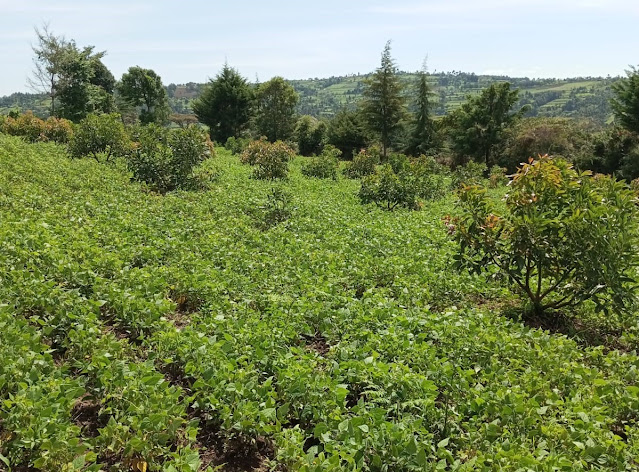At full
maturity, that is in about 7 or more years, Hass avocado trees can grow really
wide, covering up to 8m if well irrigated and fed. This size of the tree is
what advices the spacing, so we would typically say 8x8m is the ideal spacing for
Hass avocado. However, as I have mentioned, it takes a long time for the trees
to get here – 7 years is indeed a long time bearing in mind that the trees
start fruiting in the second year after transplanting.
 |
| 2 years old avocado trees covering just just about 2m space per tree |
What
would you be doing with that space between the trees before that time? Well, if
you choose to intercrop your avocado trees with shorter term crops, then that
would be perfect. But if you are raising a pure stand avocado orchard, then
that space is going to be a waste for a long time, exposing the ground to the open
sun hence excessive evaporation, not to mention the weed menace. So, shall we
make better use of that space by planting more avocado trees? Definitely! But is
it wise to do so?
The commercial 3x4m spacing
Commercial
farms actually start out their Hass avocado orchards with a spacing of 3m
between the plants and 4m from line to line. There is absolutely no harm of
doing this. It actually gives you a huge economic benefit.
Look
at this; if you start out with the 3x4m spacing, you will be having 330 trees
in one acre all bearing fruits from the second year. You enjoy the sales while
the trees continue to grow. By the 3rd year, the trees are forming a
nice canopy bringing down the rate of evaporation and weed growth – advantage! In
the meantime, the farmer who started out with the 8x8m spacing has only 60
avocado trees in an acre, giving the same number of fruits per tree as the
trees in the other farm with 330 trees.
The trees will compete for soil nutrients and caused reduced production!
Yes,
that is true but only if you let it happen. It is paramount that you prepare for
this from the very onset. The secret to solving this potential challenge is as obvious
as it sounds: replenish the soil nutrients generously. A bucket of goat
or cow manure for each tree every 3-4 months will make the trees so happy and
productive. You can choose to be a better farmer for them and do regular soil
tests to establish whether there is a particular nutrient that is draining
faster and find ways of replenishing that specifically.
 |
| Hass avocado trees intercropped with beans: this helps to replenish nitrogen in the soil |
But how do you control the trees from becoming too bushy and causing fungal diseases and reduced productivity?
The
answer first lies in pruning. A Hass avocado farmer who has chosen to go
commercial and use the 3x4m spacing must be keen on pruning to ensure that the
free flow of air and the penetration of sunlight is not compromised. However,
as you already guessed, the trees will soon outgrow the farmers effort of
pruning as the branches widen. It is at this point that the second intervention
becomes necessary: that is thinning.
What? Cut down fully grown fruiting trees?
Yes,
why not? Your aim is to raise the most profitable Hass avocado farm. It would
have taken you 3-4 productive years to get to this stage. During this time,
each of these trees were giving you optimum yields and the money you pocketed
from them has no comparison to the cost of planting and bringing them up. You
have made a profit!
So, how’s the thinning done?
There’s
no fixed formula for this since as the farmer, you will be able to observe the
trees that are becoming overcrowded and less productive. Cut down the non-productive
one. However, the cutting down shouldn’t also be done haphazardly. You should
do this with an aim of achieving a specific kind of spacing. I would recommend
removing the trees in the line so that we achieve a spacing of 6m from tree to
tree. That brings us to a 6x4m spacing which can exist till full maturity.
However, if the trees grow rapidly, you may think of removing the centre lines so as to achieve a spacing of 8m between the lines. This brings us to the 6x8m spacing that I would recommend. All this while, never overlook the importance of testing and replenishing the soil nutrients through application of fertilizers and of course, giving the plants sufficient water.

No comments:
Post a Comment